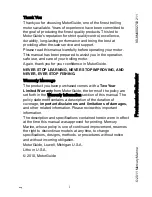
Ameba-D User Manual
User Manual All information provided in this document is subject to legal disclaimers. © REALTEK 2019. All rights reserved.
424
20.2.1.2.2
I/O Rx Mode
Every time software reads data register, one read cycle in MCU interface is triggered, so there is no Rx FIFO.
20.2.1.3
DMA Mode
The application scenario of DMA mode is shown in Fig 20-6.
Frame Buffer
Ameba-D
LCM
Display Glass
Display Control
LCDC
I8080/RGB DATA
Frame Buffer
Fig 20-6 DMA mode application scenario
DMA mode is used to send the whole frame into GRAM without CPU operation. In this mode, you must allocate a frame buffer in Ameba-D.
There are two DMA modes: Auto-mode and Trigger-mode.
Auto-mode: DMA master gets frame from frame buffer automatically based on synchronous timings.
Trigger-mode: DMA master gets frame from frame buffer manually based on register trigger, one frame one trigger. This mode is useful
when you use a LCD with internal GRAM, especially refreshing for a still image.
20.2.2
MCU Interface
The MCU interface is shown in Fig 20-7.
D[15:0]
CS
RS
WR
RD
TE_I/VSYNC_O
Fig 20-7 MCU interface
20.2.2.1
Write Cycle
The WR signal is driven from high to low and then pulled back to high during the write cycle. The data line is asserted at the falling edge of WR.
When there is a rising edge of WR, the LCD driver reads the data line.
Write cycle includes command setting and data writing. The timing parameters of command setting and data writing are illustrated in Fig 20-8
and Fig 20-9.
Realtek confidential files
The document authorized to
SZ99iot
2019-05-15 10:08:03















































